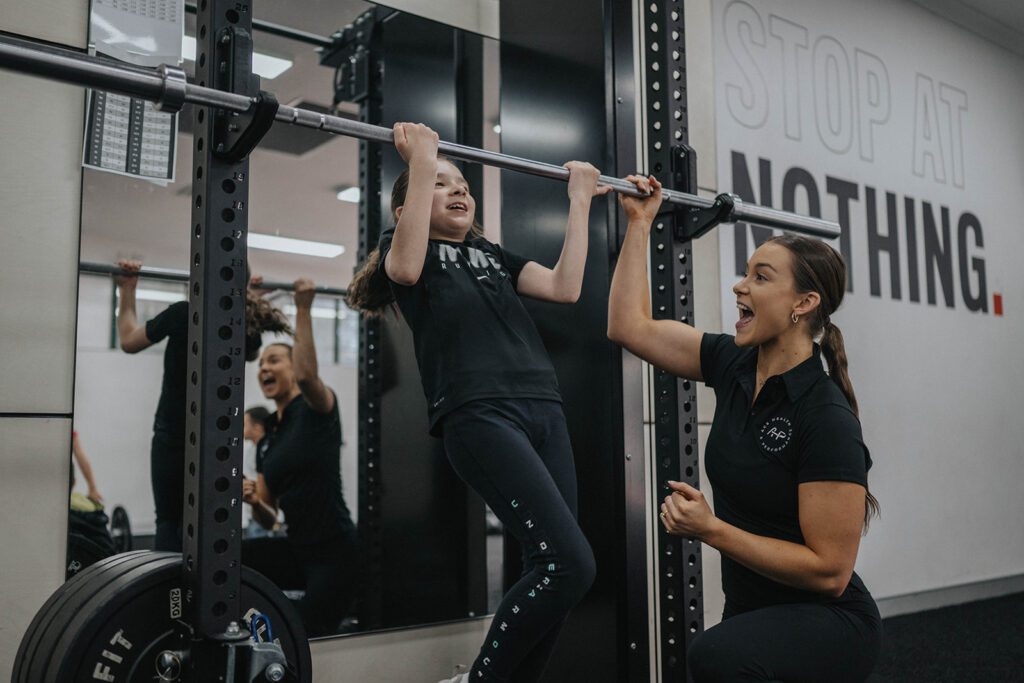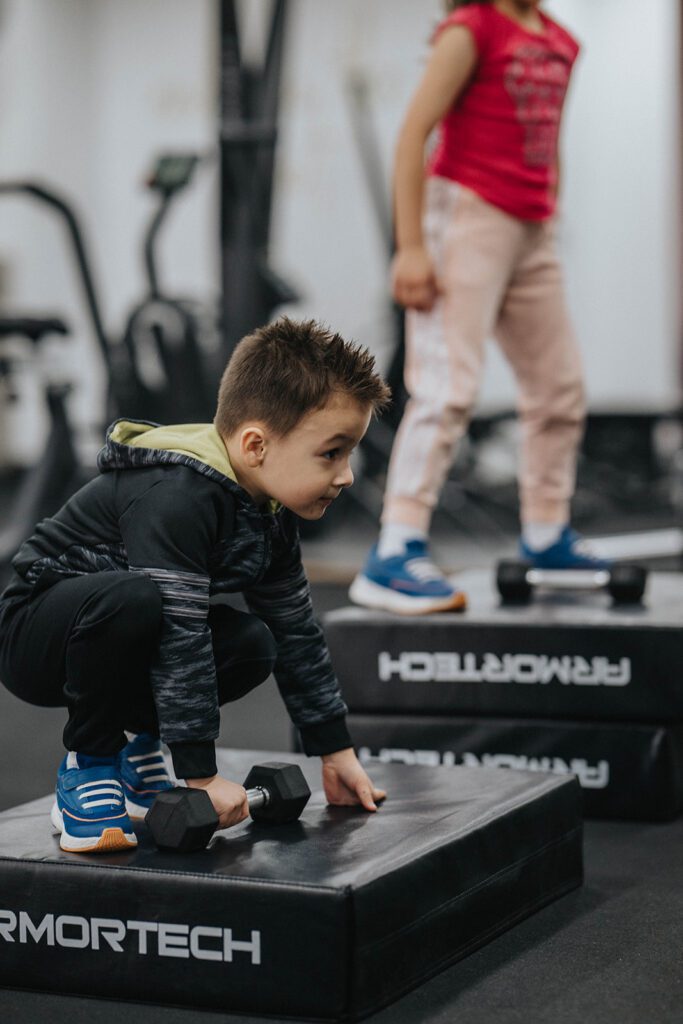Tom’s Takeaway: “Strength training in kids who have not reached puberty is safe and recommended for assisting lifelong health, exercise and sports performance goals“
I began lifting weights when I was 14 & going through puberty. As a young teenager, I started competing with my high school friends who had begun before me. It was semi-structured, unsupervised, and semi-progressive. I loved how lifting made me feel from the start, which was a large reason why I developed an intrinsic enjoyment of helping others, especially children around that age, to exercise. I became aware as an adult of the common negative beliefs about strength training for children, such as increasing injury risk, growth stunting, or simply not being beneficial until after puberty. A 2023 review by Sánchez Pastor et al. addressed these concerns, as I describe below. They analysed the literature to elaborate on the benefits and culturally assumed risks of strength training in children who have not reached puberty. As a follow-up, this blog also includes practical recommendations for designing a youth strength training program flexible around sporting time commitments.

Is lifting weights harmful for children, and will it cause injury? According to this 2023 review by Sánchez Pastor et al., high-intensity resistance training, much like for adults and the elderly, is very safe, especially when compared to other high-intensity exercises like SPORT! To emphasise without fear-mongering, sports are far more dangerous if the outcome compared is injury incidence. Positively, strength training can reduce the risk of overuse injuries in sports by about 50%, according to one highlighted study. Nowadays, strength training is commonly implemented across injury prevention programs in well-designed sports programs for all age groups. Additionally, outcomes of strength training adaptation in youth participants, including improved motor unit recruitment, muscle firing, and intermuscular coordination, have improved throwing, running, and jumping performance. Other exercise outcomes improved by strength training included sprinting, flexibility, balance, agility, and coordination. So, when combined with strength training, the evidence shows that the health and performance benefits of sport substantially outweigh the risk of injury.
Does lifting heavy weight reduce or stunt a child’s growth? There is NO EVIDENCE to suggest this. The belief probably originated from an old review hypothesising children’s bones had insufficient hormones to adapt to overload so that it might cause early growth plate ossification and deformities. On the contrary, we now know that the large mechanical stress that strength training imposes on a child’s body and growth plates is beneficial for their bone shape and density and improves their muscles and tendon health while assisting in body fat reduction, without any negative or positive impact on future growth.
Is it true that children, because of their age, cannot get stronger or grow muscle until after puberty? This misbelief might have come from early studies assessing this question that were reviewed between the 1970s and 1980s, despite positive effects of strength training being observed earlier in studies from the 1950’s. In their training study, Vrijens et al. (1978) concluded no consistent effects were observed on muscle mass or strength across all body regions. However, this study also recorded an average strength increase over eight weeks of 6.1 and 17.4 kg strength in the abdominal and back exercises, respectively. As these values are significant, then to conclude that children cannot get stronger from strength training is an erroneous conclusion that should have been caught by peer review before its publication. More accurately, as reported by Sánchez Pastor et al., “muscle strength was increased in 100% of the cases reviewed” despite changes in muscle mass not being seen consistently in many studies, indicating that just as in adults, increasing muscle strength does not mean muscle mass will increase in children. Furthermore, Sánchez Pastor et al. (2023) conclude that when safe familiarisation sessions or time periods are followed by a slowly progressive strength training protocol, pre-pubescent children benefit greatly from strength training. Also, check out the new review by Robinson et al. (2023), giving evidence from 53 studies of strength training’s positive effect on cognitive function, academic performance, and on-task behaviours across almost 2 million school-aged youth. Just like for adults and the elderly, strong muscles equal a strong brain!
Practical recommendations for prescribing strength training to youth. When applying these principles, we encourage combining progressive intensity lifting with play, fun, and cognitive challenges to improve exercise enjoyment. Training should not just be monotonous strength movements or just an obstacle course filled with gymnastics movements. Combine strength movements within creative exercise-filled games to improve long-term adherence, and create positive exercise memories.

- Allow greater than 8 weeks before expecting positive health and performance improvements.
- Adapt the strength training variables to the children’s changing tolerance and preferences.
- Start with low weekly frequency (1-2x week non-consecutively), volume (1-2 sets per exercise), intensities (6–12 repetitions while finishing each set with the child predicting at least 2-4 more repetitions in reserve), and progress over weeks and months as exercise tolerance improves.
- Like adults and the elderly, a strict lifting technique (speed and movement variability) is only uniquely important when targeting or offloading specific tissues. The lifting technique does not prevent or cause injuries independent of the dosage of any movement. All movement variability should be encouraged but progressively dosed. Preparing children for sports or play by only allowing strict movement or robotic movements in the gym is counterproductive and does not prepare youth athletes for the chaos-like requirements of sports or future physically demanding occupations. Also, over-coaching does not improve the intrinsic enjoyment of any activity. Provide tolerance to multiple movement options to complete the same task for the best outcomes. See future technique blogs for further information on this topic.
- Allow rest periods greater than 1-3 minutes if desired, as allowing rest from fatigue assists with increased strength training tolerance.
- Optional movements that can be progressively dosed long-term are listed below.
- Squatting or knee straightening movements such as a double leg squat, leg press or single leg lunge.
- Hip extension or hinging exercises such as a stiff leg deadlift and knee flexion exercises such as a machine leg curl or Nordic Curls.
- Horizontal and vertical pushing, including the chest press, push-ups, and overhead press.
- Horizontal and vertical pulling, including a row, lat pulldown, or/and pull-up.
- Low-priority exercises unless relevant to specific sports requirements.
- Rotation movements for the “core”, shoulder, and hips.
- Ankle movements involve pointing the foot upwards, downwards, inwards, and outwards (plantar flexion, dorsiflexion, inversion, eversion) and foot, and toe-specific strength exercises. Hopping activities are great for the ankles and feet.
- Back flexion movements like asit-up strengthens the “core muscles”. Back straightening (extension) strength can be achieved by most squatting and hinging movements, but back extension isolation exercises can still be implemented.
- Completing each of these movements 1-3 times a week throughout multiple sessions would make a holistic strength training program, but minimalistic programs involving 1-4 exercises are still beneficial for those with time or equipment access constraints.
- In addition to strength training movements, jumping, hopping, and landing in forwards, backward, upward, and rotational direction can also be added if needed for increasing tolerance to the demands of the chosen sport already potentially filled with these movements.
- Strength movements do not have to look sport-specific or “functional” to have positive effects on improving tissue tolerance to sport-specific movements. Many sports-specific-looking strength exercises lack the potential to progress after months and years of completion. The sports movement that you could be trying to replicate is best done while playing that sport. Health and performance effects elicited by more general strength training movements can be progressively loaded, complement the sport, and have additional life-long benefits To emphasise, 1) strength training should not replace sports training or play where possible, as we don’t want to reduce tolerance to the unique sports or physical play demands 2) Increasing strength does correlate 100% with increasing sports performance, so be careful of your expectations and 3) agility, endurance, speed and balance training should also be included within a world-class youth sport or play preparedness routine.
- These recommendations could be applied to most people starting strength training, regardless of age, who have health and performance goals.
Written by Tom Murphey, DPT.
“Unfortunately for our community, scientific scaremongering is common, easy to believe and hard to heal. Research is often messy, and strong stances or beliefs can be both erroneous and dishonest. I aim to produce honest reviews of some high-quality research to provide informed insight so you can make up your own mind on the science you value.”
References:
Robinson, K., Riley, N., Owen, K., Drew, R., Mavilidi, M. F., Hillman, C. H., … & Lubans, D. R. (2023). Effects of Resistance Training on Academic Outcomes in School-Aged Youth: A Systematic Review and Meta-Analysis. Sports Medicine, 1-15. https://link.springer.com/article/10.1007/s40279-023-01881-6
Sánchez Pastor A, García-Sánchez C, Marquina Nieto M, de la Rubia A. Influence of Strength Training Variables on Neuromuscular and Morphological Adaptations in Prepubertal Children: A Systematic Review. Int J Environ Res Public Health. 2023 Mar 9;20(6):4833. doi: 10.3390/ijerph20064833. PMID: 36981742; PMCID: PMC10049541.
Vrijens, J. (1978). Muscle strength development in the pre-and post-pubescent age. In Pediatric work physiology (Vol. 11, pp. 152-158). Karger Publishers.
More information:
Factors associated with adherence to the muscle-strengthening activity guideline among adolescents -https://www.sciencedirect.com/science/article/abs/pii/S1469029220301370
The Promise of Youth Resistance Training – https://www.thieme-connect.com/products/ejournals/html/10.1055/a-1378-3385
Free-Weight Resistance Training in Youth Athletes – https://www.ncbi.nlm.nih.gov/pmc/articles/PMC7441088/
Effects of Resistance Training on Physical Fitness in Healthy Children and Adolescents: An Umbrella Review – https://link.springer.com/article/10.1007/s40279-020-01327-3
https://www.physio-network.com/blog/weight-training-stunts-growth-an-evidence-based-myth-buster
https://www.physio-network.com/blog/why-every-kid-should-play-multiple-sports
https://twitter.com/JeremyFrisch Hundreds of youth training video examples

Comments:
share